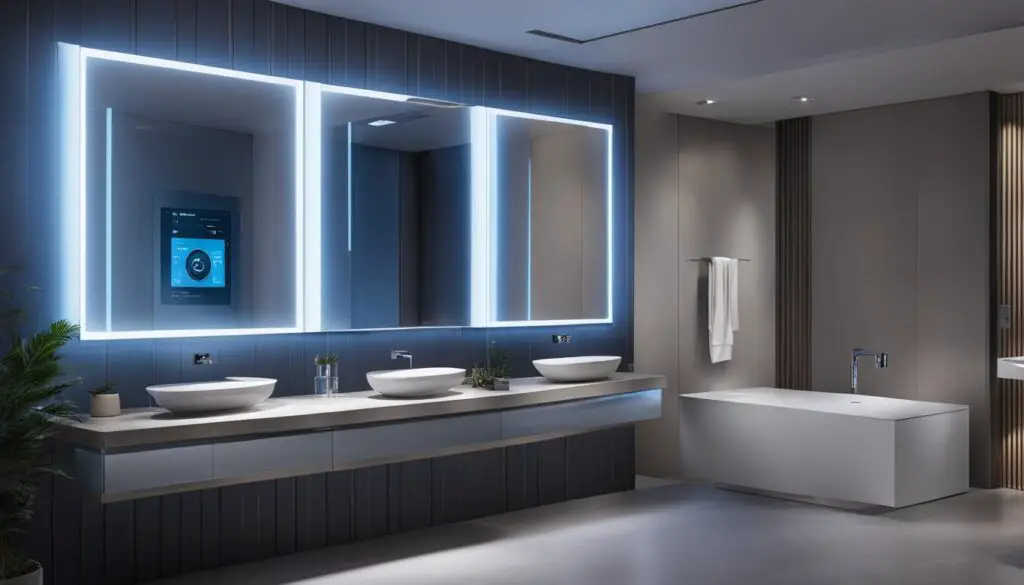Hello, I’m excited to welcome you to this beginner-friendly guide on smart bathroom technologies. In today’s ever-evolving world, technology has found its way into every aspect of our lives, including our bathrooms. Gone are the days of basic fixtures and functional designs – now we have the opportunity to transform our bathrooms into smart, futuristic spaces.
Whether you’re a tech enthusiast or just curious about how technology can enhance your home experience, this guide will introduce you to the world of smart bathroom technologies. We’ll explore the potential of Artificial Intelligence (AI) and Machine Learning (ML), discuss their applications, benefits, and challenges, and provide practical steps to get started with implementing these technologies in your bathroom.
But first, let’s take a moment to grasp what smart bathroom technologies really are. Smart bathroom technologies refer to the integration of AI and ML into bathroom fixtures and accessories, enabling them to automate tasks, analyze data, and provide personalized experiences. From intelligent mirrors that display weather updates and skincare recommendations to toilets that self-clean and adjust seat temperature, the possibilities are endless.
Table of Contents
Key Takeaways:
- Smart bathroom technologies revolutionize the way we interact with our bathrooms, enhancing convenience and efficiency.
- These technologies incorporate AI and ML to automate tasks, analyze data, and provide personalized experiences.
- We’ll explore the applications, benefits, and challenges of smart bathroom technologies in this guide.
- Practical steps will be provided to help you implement these technologies and upgrade your bathroom experience.
- Get ready for a journey into the future of smart bathrooms!
Understanding AI and Machine Learning
In today’s technological landscape, Artificial Intelligence (AI) and Machine Learning (ML) have become buzzwords that signify the potential for groundbreaking advancements in various industries. To truly grasp their significance, it is essential to understand the fundamental concepts and definitions underlying AI and machine learning.
AI can be defined as the development of computer systems that possess the ability to perform tasks that would typically require human intelligence. This encompasses a wide range of abilities, including problem-solving, reasoning, learning, and decision-making. It aims to mimic human cognitive processes, enabling machines to interact with their environments and make autonomous, informed choices.
“Artificial Intelligence is the science and engineering of making intelligent machines, especially intelligent computer programs.”
– John McCarthy, computer scientist and co-founder of AI
Machine learning, on the other hand, is a subset of AI that focuses on the ability of machines to learn from and improve performance based on data. It provides algorithms and statistical models that allow machines to automatically learn patterns, make predictions, and improve their accuracy over time. Machine learning is the driving force behind many AI applications and has proven to be instrumental in reshaping industries.
By continuously analyzing data and adapting their algorithms, machines can make decisions and carry out tasks with increasing precision and efficiency. This iterative process enables machines to learn from experience and optimize their performance, making machine learning a powerful tool for solving complex problems.
The importance of AI and machine learning in reshaping industries cannot be overstated. They have the potential to revolutionize sectors such as healthcare, finance, retail, manufacturing, and more. From enabling personalized medicine and streamlining financial operations to enhancing customer experiences and optimizing production processes, the applications of AI and machine learning are vast and diverse.
As AI and machine learning continue to evolve, it is crucial for individuals and businesses to stay informed and harness their potential. In the following sections, we will delve into specific applications of AI in smart bathrooms, explore the benefits and challenges associated with implementing smart bathroom technologies, and discuss future trends and ethical considerations. Let’s explore the possibilities together.
Key Concepts:
- AI: Development of computer systems that mimic human intelligence
- Machine Learning: Subset of AI that enables machines to learn from and improve based on data
| AI | Machine Learning |
|---|---|
| Enables machines to mimic human intelligence | Focuses on machines learning from data and improving performance |
| Wide range of abilities such as problem-solving and decision-making | Provides algorithms and statistical models for learning patterns and making predictions |
| Reshapes industries in sectors like healthcare, finance, retail, and manufacturing | Allows optimization of tasks and decision-making through iterative learning |
Applications of AI in Smart Bathrooms
Smart bathroom technologies have become increasingly popular and are revolutionizing various industries. From healthcare to finance, retail to manufacturing, AI applications are reshaping the way we experience and interact with our bathrooms. In this section, we will explore real-life examples of how AI is being utilized in smart bathrooms to improve efficiency, enhance customer experiences, and streamline processes.
AI in Healthcare
In the healthcare sector, AI is playing a crucial role in assisting doctors and healthcare professionals in diagnosing diseases and developing personalized treatment plans. By analyzing vast amounts of patient data, AI algorithms can identify patterns and predict potential health issues, leading to more accurate diagnoses and effective treatments. AI-powered smart bathroom technologies can monitor vital signs, detect anomalies, and provide valuable insights for healthcare professionals, enabling them to deliver personalized and timely care to patients.
AI in Finance
The finance industry is benefiting from AI’s ability to analyze vast amounts of financial data and optimize investment strategies. In smart bathrooms, AI applications can collect and analyze data related to water usage, energy consumption, and usage patterns. Using this information, AI algorithms can provide valuable insights on cost-saving measures, improve resource management, and optimize budget allocations. With AI-powered smart bathroom technologies, financial institutions can enhance their environmental sustainability and financial efficiency.
AI in Retail
Retailers are leveraging AI to provide personalized recommendations and enhance the customer experience. In smart bathrooms, AI applications can analyze customer behavior, preferences, and purchase history to offer tailored product recommendations. Additionally, AI can enable voice-activated assistance, allowing customers to interact with the bathroom fixtures or appliances hands-free. These AI-powered smart bathroom technologies create a seamless and personalized shopping experience, promoting customer satisfaction and loyalty.
AI in Manufacturing
The manufacturing industry is embracing AI to streamline processes and improve efficiency. In smart bathrooms, AI applications can monitor water usage, detect leaks, and optimize resource allocation. By analyzing data in real-time, AI algorithms can identify areas for improvement, detect anomalies or malfunctions, and trigger maintenance alerts. AI-powered smart bathroom technologies help manufacturers enhance productivity, reduce costs, and ensure optimal performance.
These examples highlight just a few of the many applications of AI in smart bathrooms. The integration of AI technologies is transforming the way we interact with our bathrooms, improving efficiency, convenience, and overall user experiences. The possibilities for innovation and advancement in this field are vast, and we can expect to witness even more exciting AI applications in smart bathrooms in the future.

| Industry | AI Application |
|---|---|
| Healthcare | Assisting in disease diagnosis and personalized treatment plans |
| Finance | Analyzing financial data and optimizing investment strategies |
| Retail | Providing personalized recommendations and enhancing the customer experience |
| Manufacturing | Streamlining processes and improving efficiency |
Benefits and Challenges of Smart Bathroom Technologies
Implementing smart bathroom technologies provides a range of benefits that can enhance your daily routine and transform your bathroom experience. These benefits include:
- Automation of repetitive tasks: Smart bathroom technologies can automate tasks like adjusting lighting, controlling water temperature, and maintaining optimal humidity levels, freeing up your time and energy.
- Increased productivity: With smart bathroom technologies, you can streamline your morning routine by having your bathroom prepared exactly the way you like it, saving you precious minutes.
- Improved decision-making: Smart bathroom technologies can provide valuable data and insights, helping you make informed decisions about water usage, energy efficiency, and product recommendations.
- Enhanced customer experiences: Smart bathrooms can create personalized experiences, such as customized lighting, music, and water settings, making guests feel more comfortable and pampered.
However, along with these benefits, there are also challenges to consider when implementing smart bathroom technologies. Some of the challenges include:
- Data quality: The success of AI implementation relies on accurate and high-quality data. Obtaining reliable data and ensuring its integrity can be a challenge for smart bathroom technologies.
- Algorithm biases: AI algorithms can be biased, leading to unfair or discriminatory outcomes. Addressing algorithm biases and ensuring ethical AI practices is crucial for smart bathroom technologies.
- Ethical concerns: The integration of AI in the bathroom raises privacy concerns and ethical dilemmas related to data collection, storage, and usage. Safeguarding user privacy and building trust are important considerations.
“Implementing smart bathroom technologies offers automation, increased productivity, improved decision-making, and enhanced customer experiences. However, challenges related to data quality, algorithm biases, and ethical concerns need to be addressed.”
To ensure successful implementation of smart bathroom technologies, it is important to carefully consider these challenges and develop strategies to mitigate them. By addressing these concerns, you can fully embrace the benefits of AI in your bathroom while upholding ethical standards and ensuring user privacy.

Future Trends in Smart Bathroom Technologies
The future of smart bathroom technologies is incredibly exciting. Advancements in deep learning, AI-powered automation, and robotics are set to revolutionize our daily interactions with our bathrooms. These emerging trends promise to offer a more convenient and efficient experience for users.
Deep learning, a subset of machine learning, empowers bathroom technologies to understand and respond to user preferences and habits. By analyzing vast amounts of data, deep learning algorithms can personalize and optimize various aspects of the bathroom experience, such as water temperature, lighting, and even fragrance.
Automation is another key trend that will shape the future of smart bathrooms. As technology progresses, we can expect to see increased automation of various bathroom tasks. From self-cleaning toilets to automated shower systems that adjust water pressure and temperature based on individual preferences, smart bathroom technology will streamline our routines and save us time and effort.
Furthermore, robotics will play a significant role in the evolution of smart bathroom technologies. Robots can assist with cleaning, maintenance, and even personal care tasks, making our bathroom experiences more seamless and enjoyable. Imagine a robotic companion that tidies up after us or an automated skincare device that provides personalized recommendations and treatments.
These future trends in smart bathroom technologies have the potential to transform our daily routines and enhance our overall well-being. By leveraging the power of deep learning, automation, and robotics, we can create intelligent and personalized bathroom environments that cater to our individual needs and preferences.
Aside from the remarkable advancements in technology, it’s crucial to consider the impact these trends will have on the job market. As automation and AI-powered systems become more prevalent, certain job roles may become obsolete while new opportunities emerge. This shift in the job market calls for continuous learning and upskilling to remain competitive in the evolving digital landscape.
As we embrace these future trends in smart bathroom technologies, we must also address important considerations such as privacy, security, and ethical usage of data. Striking a balance between convenience and protecting user rights is paramount in ensuring the responsible adoption of AI-powered solutions in our bathrooms.
Key Takeaways:
- Deep learning enables personalization in smart bathroom technologies.
- Automation will streamline bathroom tasks, saving time and effort.
- Robotics can assist with cleaning, maintenance, and personal care in the bathroom.
- The job market will be influenced by the rise of automation and AI in smart bathrooms.
- Ethical considerations and protection of user rights are vital in adopting AI-powered solutions.
Ethical Considerations in Smart Bathroom Technologies
The implementation of smart bathroom technologies raises important ethical considerations that need to be addressed to ensure responsible use and protect user rights. In this section, we will discuss the key ethical considerations related to privacy, bias, and transparency in smart bathroom technologies, and explore ways to address these concerns.
Privacy
Privacy is a significant concern when it comes to the use of smart bathroom technologies. With the collection of personal data through sensors and connected devices, there is a need to establish robust privacy measures to protect user information. Manufacturers and developers must prioritize data security and implement encryption techniques to safeguard sensitive data from unauthorized access or breaches.
Furthermore, users should have control over their personal data and be informed about the data collected and how it will be used. Transparent policies and consent mechanisms are vital to ensure that users have the choice to opt-in or opt-out of data collection and can trust that their privacy is being respected.
Bias
Algorithmic bias is another ethical consideration in smart bathroom technologies. As AI systems make decisions based on data, biases in the collected data can lead to biased outcomes. This can have negative implications, especially in healthcare applications where biased algorithms may lead to inaccurate diagnoses or treatment recommendations.
To address algorithmic bias, developers need to ensure that their AI systems are trained on diverse and representative data sets. Regular audits and testing of algorithms can help identify and mitigate bias in the decision-making process. Additionally, involving diverse teams in the development and evaluation of AI systems can help uncover and address any underlying biases.
Transparency
Transparency is crucial in ensuring the ethical use of smart bathroom technologies. Users should have transparency regarding the data collected, how it is processed, and the insights derived from it. This includes being informed about the algorithms used, the criteria for decision-making, and any potential limitations or risks associated with the technology.
Manufacturers and developers should provide clear documentation and instructions on the functioning of smart bathroom technologies, enabling users to make informed decisions about their usage. It is essential to establish meaningful transparency standards that foster trust between users and smart bathroom technology providers.
To summarize, ethical considerations related to privacy, bias, and transparency are vital in the implementation of smart bathroom technologies. Through robust privacy measures, addressing algorithmic bias, and promoting transparency, we can ensure the responsible use of AI in smart bathrooms that respects user rights and values.
Practical Steps for Implementing Smart Bathroom Technologies
Now that you have a good understanding of AI and its applications in smart bathrooms, it’s time to take practical steps towards implementing this innovative technology in your own home. By following these steps, you can seamlessly integrate AI into your bathroom and enjoy its many benefits.
Step 1: Identify Opportunities for AI Integration
Start by assessing your bathroom and identifying areas where AI can make a difference. Consider tasks that can be automated or optimized using AI technology. For example, you can explore AI-powered devices like smart mirrors that provide personalized skincare recommendations or voice-controlled shower systems that adjust water temperature and pressure according to your preferences.
Step 2: Collect and Prepare Data
In order to harness the power of AI, you need relevant data. Begin by collecting data related to your bathroom habits, preferences, and usage patterns. This can include data on water consumption, lighting preferences, or even your favorite bathroom products. Ensure that this data is organized and stored securely.
Step 3: Select the Right Technology Solutions
After collecting and preparing your data, it’s time to choose the right technology solutions for your smart bathroom. Research and compare different AI-powered devices and systems available in the market. Consider factors such as compatibility, functionality, and user reviews to make an informed decision. Whether it’s a smart toilet, a voice-activated faucet, or a connected shower system, select the technology that best suits your needs and preferences.
Step 4: Implement and Test the Technology
Once you have selected your AI technology, it’s time to implement it in your bathroom. Follow the manufacturer’s instructions for installation and setup, ensuring that all components are properly connected and calibrated. Once installed, test the technology to ensure that it functions as expected. Make any necessary adjustments or troubleshooting to optimize its performance.
Step 5: Monitor and Evaluate
After implementation, regularly monitor and evaluate the performance of your smart bathroom technologies. Pay attention to factors such as energy efficiency, user experience, and overall convenience. Make note of any areas for improvement or adjustments that can enhance the functionality of your AI-integrated bathroom.
By following these practical steps, you can successfully integrate AI technologies into your bathroom and enjoy the benefits of a smart home experience. Embrace the future of bathroom technology and elevate your everyday routines with AI-powered solutions.
Conclusion
Smart bathroom technologies offer an exciting opportunity to transform your everyday bathroom experience. In this beginner-friendly guide, we have introduced you to the world of AI and machine learning, showcasing their applications, benefits, and challenges. We have also provided practical steps for implementing smart bathroom technologies in your home.
By embracing these innovative technologies, beginners like you can upgrade your homes and enjoy a more convenient and efficient bathroom experience. Whether it’s automating repetitive tasks, making informed decisions with the help of AI, or enhancing your overall well-being, smart bathroom technologies have the potential to truly elevate your daily routines.
So why wait? Start exploring the possibilities of smart bathroom technologies today. With the right knowledge and understanding, you can harness the power of AI and machine learning to create a bathroom that not only meets your needs but also enhances your lifestyle. Embrace the future of bathroom technology and discover a whole new level of comfort and convenience in your own home.
FAQ
What are smart bathroom technologies?
Smart bathroom technologies refer to the integration of artificial intelligence (AI) and machine learning (ML) in various bathroom fixtures and devices, allowing for automation, optimization, and enhanced user experiences.
What is the difference between AI and machine learning?
AI refers to the ability of machines to mimic human intelligence, while machine learning is a subset of AI that focuses on enabling machines to learn from data and improve their performance.
How is AI applied in smart bathrooms?
AI has various applications in smart bathrooms, such as assisting in diagnosing diseases and developing personalized treatment plans in healthcare, analyzing financial data and optimizing investment strategies in finance, providing personalized recommendations and enhancing the customer experience in retail, and streamlining processes and improving efficiency in manufacturing.
What are the benefits of implementing smart bathroom technologies?
Implementing smart bathroom technologies offers numerous benefits, including automation of repetitive tasks, increased productivity, improved decision-making, and enhanced customer experiences.
What challenges should be considered when implementing smart bathroom technologies?
While there are many benefits, there are also challenges to consider when implementing smart bathroom technologies, such as data quality, algorithm biases, and ethical concerns.
What are the future trends in smart bathroom technologies?
The future of smart bathroom technologies is promising, with advancements in deep learning, AI-powered automation, and robotics, which can revolutionize the way we interact with our bathrooms and offer a more convenient and efficient experience. It also presents opportunities and potential impact on the job market.
What are the ethical considerations in smart bathroom technologies?
The implementation of smart bathroom technologies raises important ethical considerations, including privacy and data security, algorithm biases, and transparency. It is essential to address these concerns to ensure responsible use of AI and protect user rights.
What are the practical steps for implementing smart bathroom technologies?
To implement smart bathroom technologies, beginners can take practical steps such as identifying opportunities for AI integration in their bathrooms, collecting and preparing data, and selecting the right technology solutions. These steps will help navigate the process of harnessing the power of AI in their bathrooms.
Source Links
- https://www.yahoo.com/lifestyle/you-shouldnt-be-disgusted-when-you-take-a-shower-this-bestselling-liner-is-down-to-10-121126169.html
- https://medium.com/@TechThreads/unleashing-the-power-of-ai-discover-the-mind-blowing-potential-of-machine-learning-eb361469bf0b
- https://www.yahoo.com/lifestyle/sure-2024-just-started-signs-111604244.html


